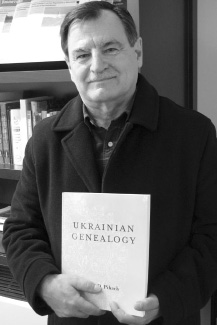 April 21,
2011 – Recent lectures on Ukrainian genealogy by John Pihach of
April 21,
2011 – Recent lectures on Ukrainian genealogy by John Pihach of Lectures on Ukrainian
Genealogy Spark Great Interest in
 April 21,
2011 – Recent lectures on Ukrainian genealogy by John Pihach of
April 21,
2011 – Recent lectures on Ukrainian genealogy by John Pihach of
In his presentation,
Mr. Pihach focused on records created during the period of Austrian rule over
Instead of
establishing a bureaucracy to maintain vital records, the Austrian authorities issued
a decree in 1782 assigning those duties to the Catholic Church, and later to other
denominations as well.
Most metrical
records begin in 1784 and, ideally, should exist in two sets—the original parish
register and a copy, the Bishops’ Transcripts. Church metrical records incorporate
much more than data on birth, marriage, and death. They can be used to study marriage
patterns, mortality rates, local epidemics, occupations of villagers, and other
aspects of village life. Parish registers preserved in Ukrainian State Archives
that are free of privacy restrictions have been microfilmed by the Church of Jesus
Christ of Latter-Day Saints (LDS) and can be borrowed locally.
The Josephinian
Cadastre (1785–88), the Franciscan Cadastre (1819–20), the Stabile Cadastre (mappings,
1819–30, 1841–51), indemnification records (1840s), and other land/tax records (1870s)
reveal the economic condition of Galician peasants and document the evolution of
the region over a long span of time. Creating cadastral maps was a task of the Stabile
cadastre, which was initiated by an edict of Emperor Francis I in 1817. The products
of that mapping include cadastral maps (Katasterkarten), field sketches (Feldskizzen),
indication sketches (Indikationsskizzen), and various texts. Both sketches
and maps were drawn to scales of 1:2,2880, 1:1,440, or 1:720. They display the exact
location of ancestral homes and fields. These cadastral records are preserved in
a number of archives in southeastern
Austrian military
personnel files prior to 1868 have also been microfilmed by the LDS and are held
at the Military Archives (Kriegsarchiv) in
On April 1,
Mr. Pihach gave a second talk to an overflow audience of more than a hundred at
the Provincial Archives of Alberta, an event organized jointly by the Alberta Society
for the Advancement of Ukrainian Studies and the Alberta-Ukraine Genealogical Project.
In his presentation, “From Your Home to the Ancestral Home: Discovering Your Ukrainian
Roots,” he focused on practical aspects of genealogical research. Unrestricted access
to materials in Ukrainian archives, locally available microfilms of overseas parish
registers, and many online databases have transformed the field. Mr. Pihach advised
members of the audience how to begin research at home with family members, other
relatives, and their friends. Information may be found in birth, marriage, or death
certificates, passports, letters, envelopes, photos, and other papers. Family histories
written by relatives may reveal not only the name of an ancestral village but also
the names of many ancestors. Local and church histories often include the place
of origin of immigrant ancestors. Provincial vital records, obituaries, and funeral-home
records are other possible sources. Naturalization records, as well as registration
and military service records of the 1940s, are reliable sources for the place of
birth of an immigrant ancestor. Passenger lists compiled overseas (e.g.,
Once the name
of the ancestral village has been determined, gazetteers can guide you to its location
on a map, including correct spelling and additional information. Google Earth can
also be used to locate the village on a map or to provide a current aerial view
of the location. The state archives in Przemyśl have expulsion records of those
whose roots are in southeastern
Ukrainian Genealogy is still available
in hardcover ($64.95) and softcover ($39.95) (plus taxes and shipping; outside
PHOTO
John
Pihach displaying his CIUS Press best-seller, Ukrainian Genealogy: A Beginner’s Guide